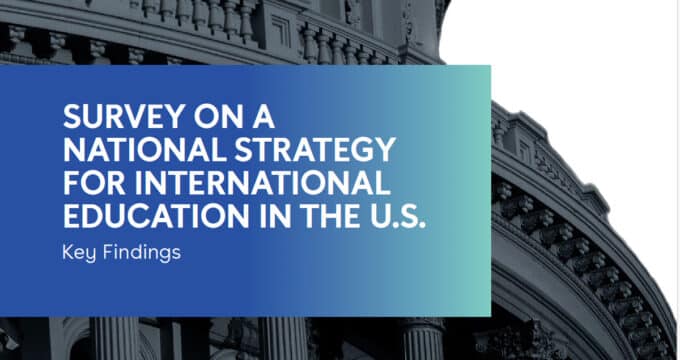International enrolment recovery underway in Australia, Canada, the UK, and the US
- Educators in the leading destinations of Australia, Canada, the UK, and the US are adopting a “post-pandemic” mindset in their approach to recruiting and they are facing a different competitive landscape
- Overarching goals are sectoral recovery and market diversification
- As a result of their individual governments’ policy approaches during the pandemic as well as government policies moving out of the pandemic, each of the leading destinations has a different recovery trajectory
- So far, the UK appears to be leading in terms of both overall growth as well as diversification, and it is seeing demand spike significantly from the key markets of Nigeria and India
In the first months of 2022, it is fair to say that educators in the top four English-speaking destinations for international students – the US, the UK, Canada, and Australia – are recruiting according to a “post-pandemic” mindset, where the assumptions are that:
- Travel restrictions are no longer expected to hamper international student mobility;
- Demand for study abroad is on the rise;
- International students are currently deciding where they want to study abroad;
- Competitor destinations are actively recruiting in priority markets.
Educators in each leading destination are aware that the competitive context for their recruiting activities has changed dramatically from what it was before the pandemic. The flow of students from China is slowing. Diversification is a major priority in all four destinations. Students have become increasingly interested in affordability, immigration opportunities, and career outcomes. One of Canada’s most powerful competitive advantages – generous post-study work rights and immigration opportunities – is under some pressure, given that the UK has reinstated post-study work rights; the US is extending OPT allowances for STEM students; and Australia is also becoming more generous with work rights as it attempts to recover enrolment declines after nearly two years of border closures.
All four destinations remain invested in their top student markets of China and India. But these markets are increasingly unpredictable and the race is on to develop other emerging markets. At this point in time, we thought we’d take a look at enrolment and visa trends in Australia, Canada, the UK, and the US as they relate to established as well as key emerging markets.
Diversification: How far along are the four destinations?
Australia’s International Marketing Strategy 2021–2030 includes a couple of fascinating comparison graphics illustrating the extent to which the top four destinations were diversified across student markets in 2020.
The first chart below tells us that in 2020:
- Australia and the US were more reliant on China than was the UK;
- Canada was much more heavily reliant on India than were other destinations;
- Australia and Canada drew a heavier share of enrolments from their top five source markets than did the US and especially the UK;
- The UK hosted a much wider set of nationalities than the US, Canada, and Australia (in part because of its proximity to the many countries of Europe and established mobility patterns from Europe to the UK).

The next chart breaks down the top five source markets for universities in each destination in 2020:
Australia: China, India, Nepal, Vietnam, Malaysia
US: China, India, South Korea, Saudi Arabia, Canada
UK: China, India, US, Hong Kong, Italy
Canada: India, China, Vietnam, France, South Korea

Keeping those top markets in mind, we will now look at trends in each country as they relate to recent increases or declines – and then move on to where notable growth is coming from emerging markets.
Australia
Australian borders were closed until very recently, only reopening in December 2021. For this reason, enrolment declines in 2021 stem largely from the fact that many international students gave up on being able to make it to Australia to study in 2020 and 2021. In 2021, the number of students enrolled in Australia fell by 17%, with declines in all five top source countries: China (-11%), India (-13%), Nepal (-13%), Vietnam (-14%), Malaysia (-23%).
However, when we look at the number of visas issued to international students in 2021, we can clearly see that Indian (+29%) and Malaysian (+19.7%) markets are once again rebounding. There is some uptick as well from Nepal (+4.3%) and Vietnam (+1.2%), but enrolments from China have not recovered as yet (-13.6%).
Impressive growth can be found in important emerging markets as well, despite these markets currently composing small portions of Australia’s total international student enrolments:
- Philippines: +62.8%
- Sri Lanka: +35.6%
- Pakistan: +21.8%
- Indonesia: +27.8%

Canada
In Canada, the number of study visas awarded to international students rebounded in 2021 to almost pre-pandemic levels. A total of 621,565 study visas were issued to international students for Canadian programmes of at least six months’ duration in 2021 – almost as many as were issued before the pandemic in 2019, when 638,380 students received study visas.
In terms of top source markets, India, as well as several other important markets, contributed strong growth, but China and Vietnam are in decline. These are the trends for visa grants in 2021:
- India: 217,410 (y-o-y +21%)
- China: 105,265 (-10%)
- France: 26,630 (+46%)
- Iran: 16,900 (+21%)
- Vietnam: 16,285 (-14%)
- South Korea: 15,805 (-13%)
- Philippines: 15,545 (+115%)
- US: 14,325 (+14%)
- Nigeria: 13,745 (+30%)
- Mexico: 11,550 (+81%)
It’s always interesting to look at the effects of government policies on enrolment trends. Canada’s International Education strategy 2019-24 included a budget provision of CDN$24.1 million over five years and CDN$5.4 million ongoing for a digital marketing effort aimed at prospective students from several priority targets: Mexico, Colombia, Brazil, Vietnam, Philippines, Indonesia, Thailand, Morocco, Turkey, France, and Ukraine. All those priority markets have grown for Canada since 2019 and since last year with the exception of Brazil (where numbers were stable) and Vietnam, which was down.
Y-o-y growth in priority student markets for Canada (2020 to 2021)
- Mexico: +80%
- Colombia: +69%
- Brazil: +1%
- Vietnam: -14%
- Philippines: +115%
- Indonesia: +28%
- Thailand: +59%
- Morocco: +30%
- Turkey: +36%
- France: +46%
- Ukraine: +3%
United States
In the US, international enrolments fell by 15% in 2020, with major declines from China (-15%), India (-13%), South Korea (-21%), and Saudi Arabia (-23%). There are no signs as yet, if we look at SEVIS data comparing visas issued in October 2021 to those issued before the pandemic in January 2020, that there is recovery underway in markets including China (-30%), South Korea (-24%), Saudi Arabia (-43%), Vietnam (-19%), Taiwan (-18%), and Thailand (-27%).
Significant markets where there are signs of a return to growth – if we compare visa data from October 2021 to data collected mid-pandemic in December 2020 – are India (+24%), Mexico (+27%), Brazil (+11%), Nigeria (19%), Turkey (+13%), Indonesia (+13%), Ghana (+22%), and Kenya (+20%).
The recovery path in the US will be different than in the other leading destinations because of the significant negative impact on international enrolments of US government policies under the former US administration. However, the Biden administration has clearly signalled over the past year that the US is once again open for business when it comes to international students and workers, and there are signs of a more active recruiting posture for the US going forward.
United Kingdom
The UK weathered the pandemic better than most in other leading destinations – from the perspective of international enrolments – and did not see a decline in enrolments at any point over the past two years. Most of its growth in 2020/21 (+9%) came from non-EU markets, a result both of Brexit dampening demand from the EU and of the UK’s restoration of generous post-study work rights in 2020 – a key driver of demand from students in emerging markets.
In terms of what happened with the five markets identified in the Australian International Strategy document as the top five for the UK in 2020, there are quite a few interesting trends. Between 2019/20 and 2020/21, according to HESA enrolment data, China actually grew slightly by 1.3% to 143,820 enrolments, India grew significantly by 52% to 84,555, the US declined by 7% to 19,220, Hong Kong was stable (16,665), and Italy was stable (14,605).
But the major story here is that there are now more Nigerian students in UK universities than American ones: 21,305 to be exact in 2020/21. This represents growth of 64% over the course of a single year. The fact that China did not decline for the UK is also important, as Australia, Canada, and the US are experiencing continuing declines from this key market. It might not be long before this changes, however, as the UK saw 5% fewer Chinese commencements in 2020/21.
The UK government has also listed study visa issuance trends for 2019, 2020, and 2021. According to this data set, the number of visas issued to Chinese students dipped by -1% from 2019 to 2021 while visas issued to Indians grew by 90%, visas granted to Nigerians jumped by a massive 236%, visas issued to Pakistanis also soared by an impressive 173%, and visas issued to Americans grew by 87%.
For additional background, please see:
- “A post-pandemic push to diversify international enrolments”
- “Surveys show that career outcomes outweigh rankings for many prospective international students”
- “ICEF Podcast: The road to pre-COVID enrolment in the world’s top two study destinations”
- “Up and down the table: Growth trends across major international study destinations”














